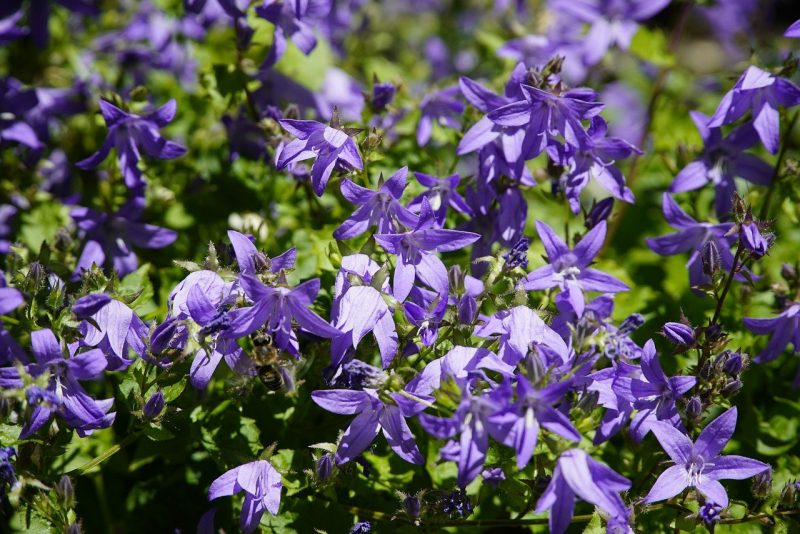Mastering how to deadhead campanula is straightforward and only requires proper timing and cutting. This article will also discuss how to care for campanulas or bellflowers and what problems may arise in growing them. Regardless, take comfort in knowing that campanulas are easy to grow, and you can always use a greenhouse to maintain their ideal environment.
Bellflowers thrive in zones 3 to 8, but it’s vital that you also use the species or cultivar ideal to your area. Otherwise, create and adjust the indoor environment and maintenance practices for growing these beautiful plants. Deadheading is one technique that will let you enjoy a longer blooming period as it maintains their health and prevents seed production.

How To Deadhead Campanula And Other Maintenance Tips For Success
Deadheading campanula
Deadheading is not only a practice beneficial for keeping campanulas neat-looking. As mentioned earlier, this practice extends the blooming period and can even encourage a second flush of the plants’ colorful flowers. As with other plants, you can check your campanulas for their fading flowers, and remove them by hand, or cut with pruners.
Ensure that you check the flower’s stem and cut it off from the new lateral bud so that your plant can bloom later on. You can also pinch off the dead flowers and remove all the other diseased parts of the plant, such as stems and leaves, to help maintain the plant’s health and focus its energy on flower production. It’s ideal for deadheading every five to seven days as maintenance and prune or cut back the stems after the campanulas finish flowering to help rejuvenate them.
Caring for campanula after planting
Besides deadheading, it’s essential that you also know the needs and requirements of campanulas to thrive successfully. For example, have you provided the plants with adequate spacing? When planting campanulas, you want them to have a space of at least 15 inches among them.
Therefore, you may need to divide these plants every spring or fall to ensure that they are not overcrowded. Remember that congested flowers affect air circulation, which can encourage diseases and pests. More so, campanulas love an area that receives direct sunlight since they require this for bloom production.
You also want to water and fertilize them adequately. However, do note that campanulas, much like other plants, won’t do well with overwatering and overfeeding. You can check the surface before watering, and an all-purpose fertilizer every spring and mid-summer should suffice. Some gardeners also mulch for moisture retention and weed control.
Common problems in growing campanula
You can use a greenhouse to make pest and disease management more comfortable. The stable growing conditions should prevent diseases like powdery mildew, but diligence is still essential so you can immediately address a budding issue. Campanula leaves can also attract aphids, snails, and slugs, so ensure that you have adequate irrigation and immediately remove these critters.
How To Get Campanulas To Re-bloom?
Gardeners want to know how to deadhead campanula to encourage it to have a longer blooming period. However, one of the reasons you are probably interested in is how to get these gorgeous plants to rebloom. In general, you can reflower a campanula in spring if you do certain practices at the end of fall when it’s going to enter dormancy.
The greenhouse would also be useful in this situation because you can place the plants somewhere bright but out of direct sunlight. Remember that campanulas require light for health, but direct sunlight can dry them quickly. However, during this period, you want to prevent overwatering and letting the soil dry before watering.
Campanulas are prone to rot, especially when overwatering during cold temperatures. Feeding during this time should also be occasional, and you can fertilize with tomato feed before they start growing. This practice should help with flowering for the next season.
How to encourage dormancy in campanulas?
Another common reason why your campanulas have underwhelming flower development is from a short dormancy period. During winter, you need to ensure that your plant undergoes dormancy. Therefore, you want to provide less water onto your plants and let the compost dry out in a location around 54°F to encourage dormancy.
With the ideal conditions and maintenance practices, one can expect campanulas to flower from late spring to early autumn. The flowers can last up to six weeks, and you can also fertilize with a high-potassium feed in addition to deadheading to extend the show. After some years, you may need to repot campanulas as well as part of regular maintenance every two years.
Conclusion
Campanulas are not only easy-to-grow additions to the garden, but given that you maintain them consistently, they should provide you with lasting blooms. One of their requirements is knowing how to deadhead campanula, which, fortunately, is another straightforward method. You’ll simply cut off or pinch the plant’s faded flowers for five days, and that’s it.
However, deadheading is not the only maintenance practice that you should do with campanulas. Remember that they require light to bloom, and proper feeding and watering will keep them healthy. It would help if you also placed them in a stable environment like the greenhouse to prevent diseases and problems much more comfortably.
